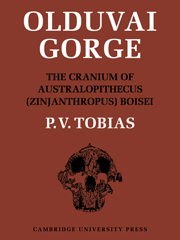Book contents
- Frontmatter
- Contents
- List of text-figures
- List of plates
- List of tables
- Introductory Note
- Foreword
- Editor's Note
- Acknowledgements
- I Introduction
- II Preservation and reconstruction of the cranium
- III The cranial vault
- IV The basis cranii externa
- V Certain critical angles and indices of the cranium
- VI The interior of the calvaria
- VII The thickness of the cranial bones
- VIII The endocranial cast of Zinjanthropus
- IX Metrical characters of the calvaria as a whole
- X The structure of the face
- XI The pneumatisation of the Zinjanthropus cranium
- XII The dental arcade and the palate
- XIII The pattern of dental attrition and occlusion, with comments on enamel hypoplasia
- XIV The size of individual teeth, absolute and relative
- XV The size of the dentition as a whole
- XVI The crown shape index of the teeth
- XVII The morphology of the teeth
- XVIII Summary of cranial and dental features of Zinjanthropus
- XIX The taxonomic status of Zinjanthropus and of the australopithecines in general
- XX The cultural and phylogenetic status of Australopithecus boisei and of the australopithecines in general
- References
- Index of persons
- Index of subjects
- Plate section
VII - The thickness of the cranial bones
Published online by Cambridge University Press: 05 November 2011
- Frontmatter
- Contents
- List of text-figures
- List of plates
- List of tables
- Introductory Note
- Foreword
- Editor's Note
- Acknowledgements
- I Introduction
- II Preservation and reconstruction of the cranium
- III The cranial vault
- IV The basis cranii externa
- V Certain critical angles and indices of the cranium
- VI The interior of the calvaria
- VII The thickness of the cranial bones
- VIII The endocranial cast of Zinjanthropus
- IX Metrical characters of the calvaria as a whole
- X The structure of the face
- XI The pneumatisation of the Zinjanthropus cranium
- XII The dental arcade and the palate
- XIII The pattern of dental attrition and occlusion, with comments on enamel hypoplasia
- XIV The size of individual teeth, absolute and relative
- XV The size of the dentition as a whole
- XVI The crown shape index of the teeth
- XVII The morphology of the teeth
- XVIII Summary of cranial and dental features of Zinjanthropus
- XIX The taxonomic status of Zinjanthropus and of the australopithecines in general
- XX The cultural and phylogenetic status of Australopithecus boisei and of the australopithecines in general
- References
- Index of persons
- Index of subjects
- Plate section
Summary
The calvaria of Zinjanthropus is a curious blend of extraordinary robusticity in parts and unusual thinness in others. Basically a thin-walled calvaria, the brain-case is modified in parts by (a) massive ectocranial superstructures, and (b) excessive pneumatisation.
Robusticity owing to pneumatisation
One could multiply measurements apace to demonstrate the unusual thickness and robusticity of different parts of the cranium of Zinjanthropus. A good area in which to demonstrate this is the region of the parietomastoid and occipitomastoid sutures, since comparative data are available, once again provided mainly by Weidenreich (1943, p. 66).
The first thickness is that of the parietomastoid suture just in front of asterion. In Zinjanthropus, this thickness measures 22·2 mm. on the left and 24·1 mm. on the right. For comparison the values in three crania (five sides) of Homo erectus pekinensis range from 15 to 18 mm.; and in modern man from 3·5 to 7·0 mm.
The second thickness is that of the occipitomastoid suture ‘medial to the mastoid process’. As in anthropoid apes, it is extremely difficult to take this measurement in Zinjanthropus because the whole pars mastoidea (not just the mastoid process) is pneumatised. For instance, in Zinjanthropus, the parietomastoid suture just in front of asterion is not the thickest part (which it is in H. e. pekinensis); instead the thickest part is to be found just behind the right mastoid process proper, where readings of 26–29 mm. can be taken.
- Type
- Chapter
- Information
- Olduvai Gorge , pp. 72 - 76Publisher: Cambridge University PressPrint publication year: 1967



